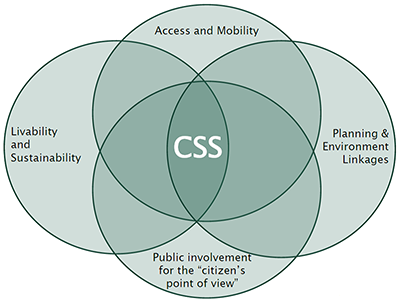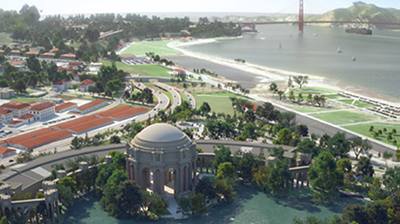
Advancing the Application of Context Sensitive Solutions (CSS):
The CSS National Dialog 2
Increasingly, State Departments of Transportation (DOTs) and local transportation agencies are employing Context Sensitive Solutions (CSS) to reduce project costs, accelerate project delivery, enhance relationships with stakeholders, and make their communities more livable and sustainable. The Federal Highway Administration (FHWA) defines CSS as a collaborative, interdisciplinary approach that involves all stakeholders to develop a transportation facility that fits its physical setting and preserves scenic, aesthetic, historic, and environmental resources, while maintaining safety and mobility. CSS considers the total context within which a transportation project exists and provides agencies with a more inclusive way to engage the public throughout the transportation decisionmaking process in order to better conserve valuable environmental and community resources. Transportation agencies can use CSS to help reach consensus among relevant stakeholders early in project development to streamline the process. As transportation agencies continue to face financial constraints, CSS serves as an innovative business model that emphasizes efficiency and effectiveness.

The CSS National Dialog seeks to highlight the linkages between CSS and key transportation focus areas, such as livability and sustainability. (Courtesy of
CTE)
This newsletter describes the FHWA CSS National Dialog program and highlights current activities related to the CSS National Dialog 2. It also provides examples of innovative CSS case studies and illustrates current and planned efforts to advance CSS implementation.
Expanding the CSS Conversation
Although the concept of CSS has been around since the late 1960s, FHWA initiated the CSS National Dialog program in 2008. It has been instrumental in spreading the word about CSS and advancing the application of CSS in transportation projects. The CSS National Dialog program, now in its second phase, is an interactive, collaborative outreach and education program that disseminates best practices, carries out a workshop series and national webcasts, and offers relevant resources to practitioners, managers, and researchers. From 2008 through 2010, FHWA, in partnership with the Center for Transportation and the Environment (CTE) at North Carolina State University, initiated the first CSS National Dialog. The goals of the Dialog are to:
- Introduce CSS principles and practices to a wide array of partner organizations;
- Identify CSS best practices and present them to transportation professionals across the Nation;
- Strengthen and broaden interest in CSS;
- Discover new opportunities for partnerships;
- Bring new perspectives to planning, designing, building, and maintaining transportation facilities; and
- Foster a CSS community of practice and promote the dissemination of CSS best practice examples.
At the onset of the CSS National Dialog program, FHWA and CTE collected over 90 exemplary case studies from across the country that showcased the wide variety of projects incorporating CSS principles into practice. FHWA and CTE, along with a Steering Committee, selected four case studies per region to be explored through five regional workshops. These regional workshops highlighted best practices, promoted knowledge-sharing, and encouraged discussion on CSS. The CSS National Dialog culminated in a national webcast that focused on discussing opportunities and new approaches to applying CSS principles as well as identifying emerging challenges.
In October 2010, FHWA and CTE published a report that documents the activities of the first Dialog, presents themes and insights from the workshops, and provides direction for future CSS initiatives. The report recommends broadening outreach and educational activities by offering more workshops, preparing additional case studies, and delivering timely research and best practices. Another key suggestion, based on input from workshop participants, is that future Dialog efforts should address how CSS relates to other national topics, such as the Moving Ahead for Progress in the 21st Century Act (MAP-21), Every Day Counts, sustainability, and climate change mitigation and adaptation.
CSS National Dialog 2: A Process for Broader Integration and Implementation
Building on these recommendations, FHWA and a diverse team including CTE, consultants, and Project for Public Spaces, a planning and design nonprofit, launched the CSS National Dialog 2 in 2012. The second Dialog helps move from concept to action by building awareness, supporting a growing community of practice, and engaging a broader and more diverse set of stakeholders. The CSS National Dialog 2 aims to achieve wider implementation of CSS by further illustrating the value of CSS for improving all phases of the project development process, including planning, design, construction, maintenance, and performance evaluation. Moreover, this second Dialog focuses on how CSS links with timely topics such as sustainability, livability, and striking a balance between needs and affordability.
Following a similar format to the initial iteration, the second Dialog features a series of ten total workshops and webcasts between 2012 and early 2014. Prior to the first workshop, FHWA and the project team put out a call for best practices, asking participants in the first Dialog to submit potential case studies. FHWA and the project team formally kicked off the second Dialog with a webcast to provide information on lessons learned from the first Dialog, themes for round two, and ways for agencies to participate. So far, FHWA and CTE have held eight total workshops and webcasts to illustrate innovative transportation projects, emphasize best practices, promote discussion, and encourage the exchange of ideas.
CSS National Dialog 2 Case Studies
- Dana to Downtown - Redding, CA
- Presidio Parkway - San Francisco, CA
- Shandon Safety Roadside Rest Area - Shandon, CA
- Dubuque Historic Millwork District - Dubuque, IA
- Uptown Circle - Normal, IL
- IL Route 3 in Waterloo - Waterloo, IL
- The Fix on I-196 - Grand Rapids, MI
- Blue Water Bridge, Port Huron, Michigan Aesthetic Design Guide - Port Huron (City and Township), MI
- Community and Transportation Linkage Planning Program - Albany, NY
- North Tryon Streetscape Redesign - Charlotte, NC
- NC 55 (Alston Avenue) Improvements - Durham, NC
- Churton Downtown - Hillsborough, NC
- Blue Ridge Road Grade-Separation Project - Raleigh, NC
- Mill Creek Valley and I-75 - Cincinnati, OH
- Pop Up Rockwell - Cleveland, OH
- I-83 Master Plan - Harrisburg, PA
- Winslow Way Street Planning and Design - Bainbridge Island, WA
- Sunset Area Community Revitalization - Renton, WA
- Communities Putting Prevention to Work: Draft Safe and Complete Streets Plan - SeaTac, WA
Case Studies Emphasize Streamlining, Cost Effectiveness, and Sustainability
Throughout the first and second CSS National Dialog, FHWA and CTE have identified exemplary case studies that incorporate multiple aspects of CSS best practices. As part of the CSS National Dialog 2, FHWA and the Dialog team have presented 20 case studies that capture current and evolving transportation themes and how they directly relate to CSS (see the text box to the right for more details). Many of these themes are also connected with the goals and desired outcomes of MAP-21, such as performance management, and are therefore becoming an important focus for transportation agencies.
The following examples provide snapshots of how CSS case studies from the second Dialog address streamlining, cost effectiveness, and sustainability.
The Fix on I-196: This project exemplifies both streamlining and cost effectiveness. Located in Grand Rapids, Michigan, the Fix on I-196 will reconstruct a portion of the Gerald R. Ford Freeway. Through extensive community outreach, the Michigan DOT and the city of Grand Rapids gained community support for shutting down the entire roadway during construction to accelerate project completion. The project team was able to foster continued communication and collaboration with stakeholders to achieve consensus and ensure that the project benefitted the community. Reaching consensus proved essential to limit inconveniences to travelers during construction and to better incorporate community enhancements, such as installing sidewalks on the new bridges and creating a parallel nonmotorized path, into the project.

This image is a rendering of the selected alternative for the Presidio Parkway project in San Francisco, California. (Courtesy of Caltrans)
Presidio Parkway Project: This project illustrates CSS’s cost effectiveness and streamlining benefits. The Presidio Parkway project will reconstruct a six-lane section of Highway 101 that connects the city of San Francisco to the Golden Gate Bridge. Through continuous engagement of diverse stakeholders, the California Department of Transportation (Caltrans) resolved a decades-long project stalemate related to issues such as noise, environmental impacts, and the historic value of adjacent communities. Reaching consensus among the stakeholders, Caltrans was able to address the factors that were delaying the project and move it into construction. Incorporating CSS through consensus building and preserving and enhancing community and natural environments proved to significantly reduce costs by accelerating project delivery.
Uptown Circle: This final example from Normal, Illinois, is representative of agencies using CSS to contribute to sustainability. The town of Normal originally intended for the Uptown Circle project to address traffic congestion and calm traffic caused by the intersection of five streets. However, using a CSS approach, the town was also able to integrate sustainable components by incorporating a stormwater management system and providing a green gathering space for the community. Feedback and support from the community during the public outreach process made these additions possible.
The Future of CSS
As exemplified by the case studies, CSS serves as an innovative way to enhance communities, streamline the transportation decisionmaking process, accelerate project delivery, sustain resources, and support livability, among other benefits. Moving forward, the CSS National Dialog 2 will host at least three more workshops in December 2013 and the spring of 2014. FHWA and the Dialog team anticipate wrapping up the second Dialog in May 2014 with a final webcast that will bring FHWA staff together with presenters from previous workshops and webcasts to reflect on the Dialog and discuss next steps. Beyond the Dialog 2, FHWA has formed a Livability and CSS Working Group to discuss, identify, and develop future CSS efforts at the national level.
Contact Information
Bruce Bender
Office of Project Development and Environmental Review
Federal Highway Administration
(202) 366-2851
bruce.bender@dot.gov
Rodney Vaughn
Environment Technical Service Team
Federal Highway Administration
Resource Center
(720) 963-3238
rodney.vaughn@dot.gov
Damon Fordham
Cadmus Group
(703) 842-5524
damon.fordham@cadmusgroup.com
James Martin
CTE
North Carolina State University
(919) 515-8620
jbm@ncsu.edu
Look What’s New!
- On Thursday, December 12, FHWA and CTE will host a CSS National Dialog 2 workshop and webcast in Santa Fe, New Mexico. The workshop will include an up-to-date overview of CSS and presentations on exemplary CSS projects, plans, and programs from the surrounding region.
- FHWA recently released the Performance-based Planning and Programming Guidebook. FHWA designed this Guidebook to help transportation agencies understand the key elements of a performance-based planning and programming process and the relationship of these elements within existing planning and programming processes. The Guidebook provides examples of best practices to help support the implementation of performance-based planning. Click here for more information.
Successes in Stewardship is a Federal Highway Administration newsletter highlighting current environmental streamlining and stewardship practices from around the country. Click here to subscribe to the newsletter, or call 617-494-2092 for more information.

